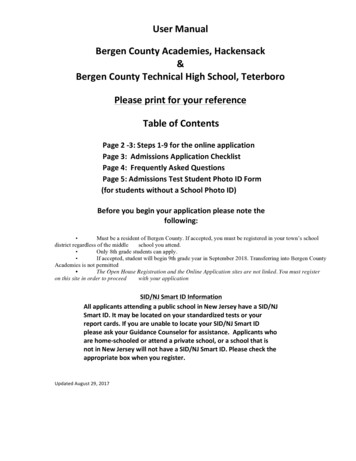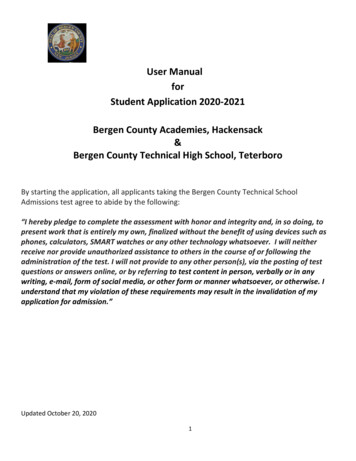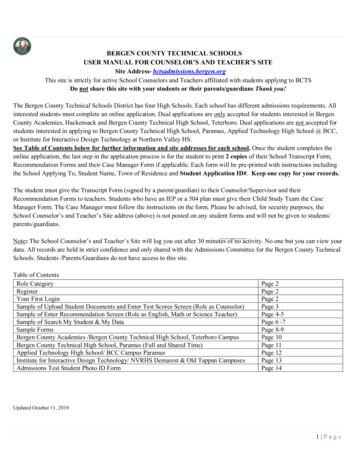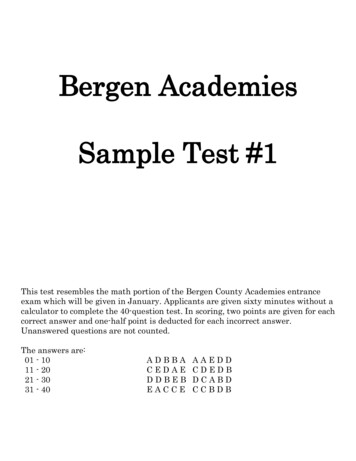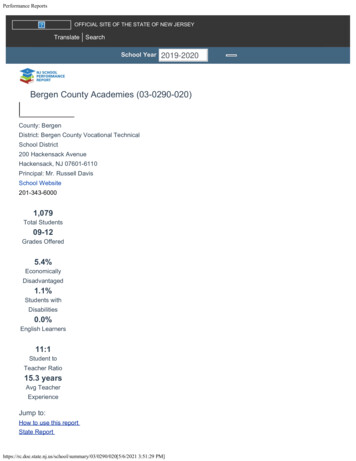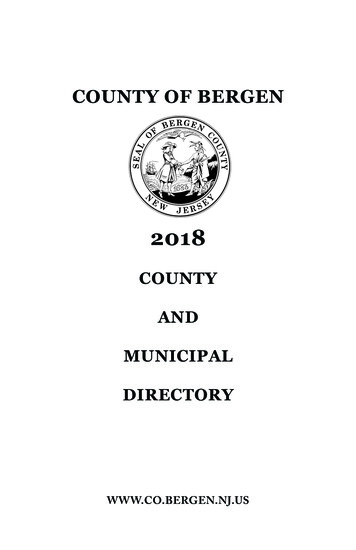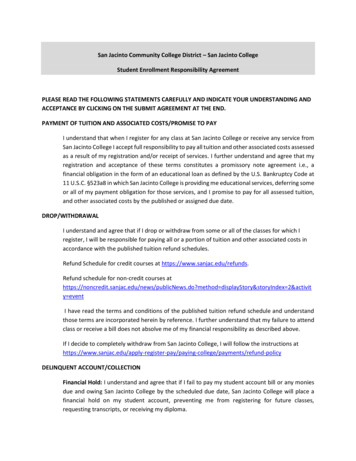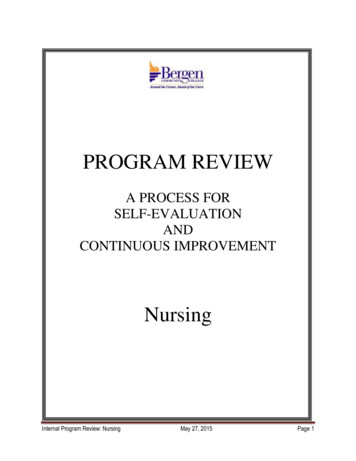
Transcription
PROGRAM REVIEWA PROCESS FORSELF-EVALUATIONANDCONTINUOUS IMPROVEMENTNursingInternal Program Review: NursingMay 27, 2015Page 1
BERGEN COMMUNITY COLLEGEOVERVIEWDescription and Mission of the Department of NursingThe Bergen Community College (BCC) Nursing Program prepares its graduates toassume an entry-level position as a registered nurse. Nursing students are actively involved asself-directed, responsible partners in the learning process. Students are educated in theclassroom, in the nursing skills and simulation laboratories and in a variety of clinical settings.The program uses technology such as Computer Assisted Instruction (CAI) and the Human Childand Adult Patient Simulators to enhance learning, skills mastery and critical thinking in theapplication of the nursing process.The College‟s Vision and Mission Statements, found in the College catalog(www.bergen.edu) are the institution‟s guiding principles. These statements are subsumed in theNursing Department‟s Philosophy. The College Vision and Mission Statements address ourcommitment to a learning community, a service community, a diverse community, and apartnership community. The goal of the institution, and the Nursing Program, is to provideeducational programs that prepare students with the knowledge, skills, and attitudes necessary toachieve employment goals and to enhance their personal and professional growth throughlifelong learning.Graduates of the BCC Nursing Program are employed in most of the healthcare facilitiesin the college‟s service area. Graduate Survey results indicate that the nursing program preparedsafe graduates for an entry level Registered Nurse (RN) position. Measures of success includeongoing full-accreditation by the Accreditation Commission for Education in Nursing [ACEN](formerly, the National League for Nursing Accrediting Commission [NLNAC]) and ongoingapproval by the New Jersey Board of Nursing (BON). In addition, the program has been inoperation for 45 years.PhilosophyThe Department of Nursing is an integral part of BCC and subscribes to the Philosophy,Vision, Mission, and goals statements of the College. The Nursing Program is designed tocomply with the definition of professional nursing practice as stated in the Nurse Practice Act ofthe State of New Jersey. The Nursing faculty recognizes the impact of our highly developed,technological, culturally diverse society upon the health care delivery system. The NursingProgram emphasizes the health care practitioner‟s mandate to be responsive to the needs ofindividuals in our ever-changing society. The nursing curriculum, designed by the faculty,Internal Program Review: NursingMay 27, 2015Page 2
utilizes Orem‟s Self-Care Model as a framework to plan and implement the educational ProgramOutcomes.Program OutcomesThe graduate of this program: Applies the Nursing Process to assist individuals, families and groups in the promotion,maintenance and restoration of optimum health Adapts the nursing process according to an individual‟s developmental capabilities. Communicates effectively with individuals, families and other health team members. Incorporates knowledge of biological, psychological, sociological, cultural, spiritual andeconomic factors in the provision of care. Assumes responsibility for personal, professional, and educational development. Practices within the legal and ethical framework of nursing. Incorporates technical resources for the improvement of nursing practice. Models critical thinking in the application of the nursing process to the care ofindividuals. Demonstrates quantitative reasoning skills in nursing practice. Integrates teaching and learning principles into nursing practice.Approved by Nursing Faculty 5/2006; Reviewed by Nursing Faculty 5/2014Program goalsThe BCC Nursing Program will: Maintain accreditation from the New Jersey Board of Nursing. Maintain accreditation from the Accreditation Commission for Education in Nursing. Collaborate with college-wide efforts to maintain accreditation from the Middle StatesAssociation of Colleges and Schools. Graduate individuals, 80% of whom will pass the NCLEX-RN on the first testing.Internal Program Review: NursingMay 27, 2015Page 3
Graduate individuals, 80% of whom will obtain employment in nursing within 12 monthsof successful completion of the NCLEX-RN based upon geographical norms for ADNemployment. Graduate individuals who demonstrate involvement in continuing education. Graduate individuals prepared to safely deliver care in a variety of health care settings. Graduate individuals capable of administering care in a technologically complexenvironment. Graduate individuals who are competent when assuming the role and responsibilities ofthe registered nurse. Graduate individuals who demonstrate technological competency.Reviewed by Nursing Faculty 5/2014Summary of Significant Developments since the last Program ReviewAdministration and StaffThe Department of Nursing has undergone a complete administrative and staffingreorganization within the past few years. Departmental oversight was traditionally under thepurview of a Director and Assistant Director with the assistance of a level I Secretary. TheDirector, Assistant Director and level I Secretary retired within the last two years. In order tomeet the needs of the Department of Nursing, an Associate Dean, Assistant Dean/ClinicalCoordinator and a Senior Secretary were hired.In March 2013, Dawn Kozlowski PhD, RN, CNE, joined the BCC Department ofNursing as the Associate Dean. Dr. Kozlowski has worked in nursing education for the past 25years. Her most recent administrative appointments included Associate Professor and AssociateDirector at Caldwell College in Caldwell, NJ (August 2012 – March 2013); Assistant Professorand Assistant Dean of Undergraduate Programs at the University of Medicine and Dentistry ofNJ (UMDNJ) School of Nursing (SON) in Newark, NJ (2004-2009); and, Assistant Professorand Director of the MSN in Education Program at UMDNJ SON (2009-2013). She holds abaccalaureate in nursing from Kean University, a master‟s in Nursing Education from New YorkUniversity and a doctorate in Health Services from Walden University. She holds certification inonline learning from Walden University and is a Certified Nurse Educator (CNE) from theNational League for Nursing (NLN).Dr. Kozlowski is qualified to provide direction to the BCC Department of Nursing. Asuccessful teacher, program evaluator and academic administrator, Dr. Kozlowski has providedoversight to a complex undergraduate curricula with 4 programs of study which included, ADN,generic BSN, RN-BSN, and Accelerated BSN programs. She has managed academic budgets asInternal Program Review: NursingMay 27, 2015Page 4
large as 4 million. The blending of expert educator, program evaluator and academicadministrator makes Dr. Kozlowski an especially good fit for leadership of the BCC Departmentof Nursing.The program was faced with ongoing challenges of evaluating current clinical settings,obtaining new and varied clinical settings, and developing processes and policies for clinicaleducation. Also, as the program has reduced the clinical group sizes to enhance student learning,additional adjunct faculty were hired. A position was needed to offer professional development,manage, and evaluate clinical and lab adjunct faculty. The position is that of Assistant Dean andClinical Coordinator, which was filled in May, 2014 by Dr. Pamela Forte.Dr. Forte has worked in nursing education for the past 29 years. Her education includes abaccalaureate and Master of Science degree in nursing (MSN), as well as a Doctor of NursingPractice (DNP) degree. She has held the positions of Senior Clinical Coordinator and ClinicalCoordinator (2007-2014) at Quinnipiac University with nursing students enrolled in genericBachelor of Science in nursing (BSN), accelerated BSN, MSN, and DNP programs. Dr. Fortehas also worked as an adjunct nursing faculty member teaching in clinical and laboratory settingsat Quinnipiac University‟s nursing program (1997-2007). Her career in nursing education began(1986-1996) as a nursing instructor teaching in the classroom and clinical settings at St FrancisHospital School of Nursing, a diploma nursing program.Dr. Forte has a strong background in developing partnerships with clinical agencies,building innovative clinical learning environments, providing professional development foradjunct faculty, and developing residency programs for nursing students. She also hasexperience in grant writing, strategic planning, program accreditation and evaluation, curriculumrevision, and working inter-professionally with diverse teams of health care practitioners.The program also hired a new full time Senior Secretary, Wendi Swaffield in January of2014. The Senior Secretary provides high-level administrative support for the HealthProfessions/Nursing department including but not limited to preparing reports, handlinginformation requests and other clerical functions such as preparing correspondence, receivingvisitors, arranging conference calls and scheduling meetings.FacultyAlthough the department has 16 full-time nursing faculty (13 tenure/tenure track and 3lecturers) educated at the master‟s or doctoral degree levels, the program has seen the departureof several full-time, tenured faculty. One Adult Health (Med-Surg) line has been replaced by alecturer and another Adult Health line has not been replaced; instead, an adjunct has been hiredto co-teach the lecture and lab portion of the course. A full time, tenure track maternal childhealth position was filled in 2014 after one of our FT tenure-track faculty members retired. Ofmost concern, due to faculty relocation and faculty retirement, there are neither tenured, norInternal Program Review: NursingMay 27, 2015Page 5
tenure track faculty instructing students in mental health content. Student instruction is currentlybeing delivered by lecturer & adjunct faculty in the psych/mental health nursing course.Admission criteriaWEXAs a result of the College‟s General Education Committee’s deliberations andinvestigation into the (1) transferability of the required 3 credits in Wellness and ExerciseScience for a number of programs in Bergen Community College and (2) concern for Nursing‟s69 credit degree, which is over the recommended limit for an Associate degree in New Jersey by3 credits, the 2 credit Dynamics of Health & Fitness and the 1 credit WEX experiencerequirement was omitted from the Nursing Curriculum and other programs at BergenCommunity College (BCC).Therefore, the Associate in Applied Science Degree in Nursing was reduced from a 69credit requirement to 66 credits, with 33 credits in nursing and 33 credits in general educationcourses.The change became effective in Fall 2012. WEX (3 credits) was a requirement for allthose nursing students admitted prior to fall 2012 (ie, up to and including January 2012). Thetotal number of credits those students were to complete was 69 (36 general education – 33nursing). Students admitted in September 2012 and thereafter are NOT required to take WEX.The total number of credits those students must complete is 66 (33 general education – 33nursing).Admissions examThe nursing program can potentially admit ninety (90) day students every fall and eighty(80) evening students every spring. The actual admission number is dependent upon the numberof repeat students for that cycle. For example, there are 14 repeat students for the fall 2015 levelI (semester 1) group. That means that the nursing department will be able to admit seventy-six(76) new day students (14 76 90) for fall 2015.Traditionally, the program has used the HESI admission exam (A2) as the sole criteria foradmission into the nursing program. Based on research conducted by the program‟s nursingadmission committee, the policy has been changed to include the student‟s GPA as part of theadmission criteria. Admission candidates are ranked according to their overall score that iscalculated from their GPA (40%) and the A2 cum score (60%). This nursing admissions policywas implemented in spring 2014. A cut-score was not identified at that time. After a carefulreview of the admitted students‟ overall score, it is noted that the lowest A2 cum scores were asfollows: sp 2014 74%; fa 2014 59%; sp 2015 75% and fa 2015 74.67%. There wassignificant variation in the Math, Science and English composite scores for all admission cohortsInternal Program Review: NursingMay 27, 2015Page 6
in the cycles cited above. The GPA‟s played a significant role in the fall 2014 cohort ranking;GPA‟s for this group were as follows: 4.00 16 students, 3.90-4.00 9 students, 3.50-3.90 43students, and 3.27-3.49 17 students. Please also note that cited GPAs may not be reflective ofscholastic ability as many students take one or two classes per semester. Michael DiBartolomeo,our new Dean of Enrollment Services, has agreed to provide a cumulative GPA for each nursingcandidate in the future. Meaning that the admissions department will calculate a true GPA basedon all of the transcripts received for each candidate; this will decrease the potential of a skewedranking due to inflated GPAs.The faculty has reviewed admissions statistics since the 2014 policy change and hasdetermined that a cut-score of 78% for the Math composite score, Science composite score, andthe English composite score be instituted for the spring 2016 admissions cycle. The Departmentis currently seeking the necessary approvals for this change in policy.Remedial MathAll students must take the Basic Skills Placement prior to admission. This test willdetermine the need for developmental coursework. All developmental coursework must becompleted before entry into the first nursing course sequence. Developmental Math courseswere revised for fall 2014. Students were previously required to take MAT035 or MAT031/032.MAT035 or MAT031/032 has now been changed to MAT 040.Student InstructionNew initiatives that have been implemented to enhance student learning and retention include: Faculty tutoring of level 4/senior students prior to HESI/NCLEX testing in spring 2014;resulting in approximately 50% of the participating students identified as weak passedNCLEX. Inclusion of standardized testing (HESI) throughout the curriculum (20% of total coursegrade) and a comprehensive HESI (20% of total course grade) as part of the final courseaverage Recommendations for remediation for „high risk‟ students (ASAP). The ASAP policywas initiated in the fall 2013 semester. The purpose of this policy was to identify “atrisk” students and to provide guidance to enhance students‟ learning experiences,improve retention, and course grades. Data was collected in the fall 2013 semester todetermine whether students were following through on this policy (see Appendix A).The ASAP policy is currently undergoing a re-assessment by the nursing faculty forpotential modifications or replacement of this policy.Internal Program Review: NursingMay 27, 2015Page 7
Three iPads were purchased and placed in the library for student use in the fall 2014 andspring 2015 semesters. The purpose of the iPads is to improve student engagement andstudent success in the nursing program. The objectives are listed below:1.2.3.Encourage student use of technology in the classroom and in the clinicalsetting to support evidence-based practice, research, and knowledgeIncrease the availability of learning resources in the classroom and in theclinical settingProvide students with needed information that is accurate and timely forenhancing learning in the classroom and in the clinical settingApplications were placed on the iPads to assist students in preparing for the nationalnursing licensing examination (NCLEX). Data collected on the usage of the iPads by nursingstudents in the fall 2014-spring 2015 semester demonstrated a total of 106 times the IPADs havebeen logged as signed out in the library. Creation of assignments that engage students and improve accountability for self-directedlearning. HESI case studies have been assigned as an ungraded, self-directed learningactivity in many nursing courses. In the spring of 2015 an additional adult human patient simulator, SimMan 3G waspurchased. Training has been completed for 13 nursing faculty, 4 respiratory therapyfaculty, and 1 paramedic science faculty member. Plans are being developed for aproposed fall 2015 inter-professional implementation with the other BCC HealthProfessions‟ departments.Internal Program Review: NursingMay 27, 2015Page 8
FOCUS ON STUDENTSDemographicsThe following two tables show the program‟s enrollment by Gender and Ethnicity/Race for theFall 2012 and the Fall of 2013.Enrollment by Gender and Ethnicity/Race Fall 2012RaceMaleFemaleWhite40.3%50.2%Hispanic (or Unknown9.7%7.5%All Other0.00%1.3%Enrollment by Gender and Ethnicity/Race Fall 2013RaceMaleFemaleWhite34.3%43.7%Hispanic (or Unknown15.7%9.7%All Other2.9%9.2%The BCC Nursing Program‟s demographic data reflects the most common ethnicity/racereported for both males and females was White, followed in second place by Asian for males andHispanic for females. Comparing BCC‟s ethnicity/race statistics to other Associate Degree RNprograms in the state of New Jersey shows White was the predominant Ethnicity/Race, butunlike BCC, Black is reported as the second highest in race/ethnicity, followed by Hispanic. Thestate of New Jersey data below does not separate the race/ethnicity by gender.Internal Program Review: NursingMay 27, 2015Page 9
Race/Ethnicity of Graduates of Associate Degree RN-Producing Programs in 2006ProgramADWhite60.2%BlackAsian/PI Hispanic NativeMore Than OtherAmerican 1 Race19.8%6.4%10.0%0.7%0.09%2.7%Source: New Jersey Collaborating Center for esearch/2006 njccn educational capacity report rn.pdfEnrollmentStatistics on enrollment versus completion rates for a five year time period in the BCCDay and Evening Nursing Programs are shown in the tables below:Day Program Fiscal Year Enrollments vs. Completions, 5 YearsTotalEnrolled(includes day andCompletedevening cohorts)20092010201120122013All Years1461711681671598113753556653264Evening Program Fiscal Year Enrollments vs. Completions, 5 YearsTotalEnrolled(includes day andCompletedevening cohorts)20092010201120122013All Years21921823122722311185551565959280From the data presented on completion rates, for most years in the five year time period,the day program students have demonstrated higher rates of completion as compared to theevening program students. It is important to note that the day program admits 10 more studentsthan the evening program (ie, 90 day students in fall and 80 evening students in spring).Additional data is needed to determine why attrition rates are high in both programs, butparticularly higher in the evening program. Based on the information cited in the tables aboveInternal Program Review: NursingMay 27, 2015Page 10
the actual attrition rate is approximately 50% from time of admission to graduation (2 years).Students must complete all degree requirements within four (4) consecutive years per nursingpolicy. Retention has not been calculated for a 4 year period.Student SatisfactionGraduates‟ Answers to the Main Graduate Follow-up Survey conducted by BCC 2008-2012Surveys are mailed to all graduate students. The table below provides the number of graduatesresponding to the overall graduate survey by calendar year.Number of Total Respondents to the Graduate Survey by Year200820092010201120123126291415Below is a list and frequency count of similar Student Satisfaction subjective commentsreceived in the years spanning 2008-2012. The numbers of students providing subjectivecomments was low in comparison to the number of students responding to the
Internal Program Review: Nursing May 27, 2015 Page 2 BERGEN COMMUNITY COLLEGE OVERVIEW Description and Mission of the Department of Nursing The Bergen Community College (BCC) Nursing Program prepares its graduates
